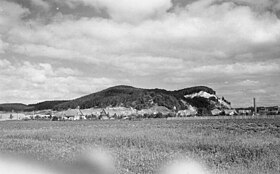Kohnstein
| Kohnstein | |
|---|---|
 |
|
| Highest point | |
| Elevation | 334.9 metres (1,099 ft) |
| Prominence | 300 m (980 ft) |
| Coordinates | 51°32′32″N 10°44′39″E / 51.54222°N 10.74417°ECoordinates: 51°32′32″N 10°44′39″E / 51.54222°N 10.74417°E |
| Geography | |
| Location | Thuringia, Germany |
| Map of the Mittelwerk complex |
The Kohnstein is a hill, 2 kilometres southwest of the village of Niedersachswerfen and 3 kilometres northwest of the centre of the town of Nordhausen. Gypsum mining created tunnels in the hill that were later used as a fuel/chemical depot and for Nazi Germany factories, including the Mittelwerk V-2 rocket factory that used Mittelbau-Dora slave labour.
1917–1934: The Badische Anilin- und Soda-Fabrik (BASF) purchased the property and mined anhydrite for gypsum.
1935 summer: At the suggestion of IG Farben, the Wirtschaftliche Forschungsgesellschaft (WIFO) (English: Economic Research Company) investigated the mine to centralize a fuel and chemical depot.
1936: Wifo took over the mines to create a highly secret central petroleum reserve. The Government's Industrial Research Association invested some effort in adapting the tunnels and galleries for the storage of critical chemicals like tetra-ethyl-lead (petroleum anti-knock).
1937–1940: Wifo phases I and II to extend the tunnels were completed, and the site stored oil, gasoline, and chemicals; as well as stockpiles of chemical poisons.
1943 July (mid): A production planner for Gerhard Degenkolb (i.e., the A-4 Special Committee), Paul Figge, determined that the site seemed ideal for A-4 production, but Hermann Göring initially forbade the use for missile production (Hitler overruled).
1943 August (end): The Armaments Ministry seized the facility from Hermann Göring's Four-Year Plan organization.
1943 November (late): Mittelwerk GmbH leased the Kohnstein mine from Wifo, the owner.
1943 September early: Albin Sawatzki, Arthur Rudolph, and about ten engineers moved to the Nordhausen plant from Peenemünde.
1943 September: Conversion of tunnels for V-2 rocket production was started.
1944 Spring: Ventilation and heating construction was completed.
...
Wikipedia

